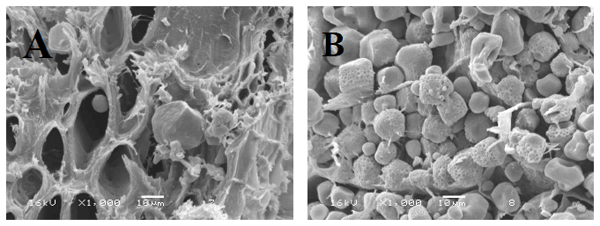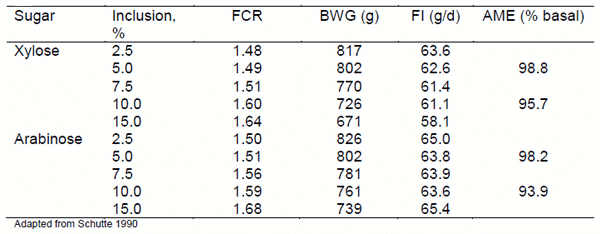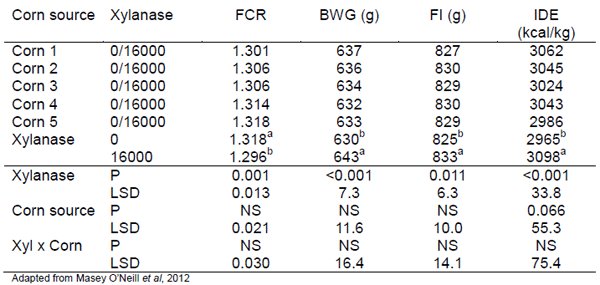The interaction between cereal quality and enzyme use in animal feed
Published: February 10, 2014
By: Helen Masey O’Neill, Tiago Santos, Jorge Rubio, Daniel Camacho and Michael Bedford (AB Vista Feed Ingredients Ltd, UK)
Introduction
In recent years, the cost of energy for feed has increased, with increasing demand for cereals from the biofuels industries. It follows that there is currently pressure on feed manufacturers to maximise their efficiency of nutrient utilisation, particularly of energy but also phosphorous. The net result is that feed manufacturers are moved to consider use of feed additive enzymes such as xylanase for releasing more energy from corn and sorghum, which they may not previously considered as economical. They may also consider using phytase at considerably higher dosages than currently employed. Not only does this latter activity increase phosphorus retrieval from phytate, but it also spares energy as a result. Furthermore, there has recently been improved understanding of the prediction of quality of cereals and a greater ability to do so using NIR. This can help to formulate diets more accurately and economically and possible even make changes on a live basis. It can also help to direct the inclusion of enzymes.
NSP enzymes for corn based diets
Glucanase enzymes were the first non-starch polysaccharide (NSP) enzymes developed, for use in viscous barley based diets. Non-starch polysaccharide enzymes were later developed for wheat based diets with the introduction of xylanases. Decreases in gut viscosity and improvements in litter quality translated to an improvement in animal performance (Bedford and Classen 1992). With wheat based diets, an increase in gut viscosity is attributed to the soluble arabinoxylan (AX) content of the grain; total AX may represent up to 8% of the grain with 2% being soluble (Choct et al 1997). Even though corn and sorghum both contain appreciable amounts of AX, maybe 5 or 2% respectively (Choct 1997) the use of such enzymes is not associated with improved litter quality because the AX in this case is largely insoluble. However, such material remains a substrate for xylanase although the scale of the animal performance response may be muted compared with wheat. As a result the rate of uptake of such products in the market has been relatively slow but is gaining momentum especially as understanding of the mechanism of action is such diets is growing.
Mode of action
It is thought that NSP enzymes function through three separate mechanisms, either alone, or more likely, in combination. These activities include plant cell wall destruction, reduction of digesta viscosity and a putative prebiotic mechanism.
The cell walls of the starchy endosperm of cereals are constructed of a small amount of cellulose entwined with hemicellulose, the bulk of which is AX (Saulnier et al 2012) Monogastric species do not have the endogenous enzymes such as xylanase, necessary to degrade plant cell walls. As such, the contents of some cells remain intact following milling, processing and the grinding action of the teeth or gizzard. Cell wall degradation can be improved with the use of sufficient amounts of the appropriate enzyme activity so that the cell is broken open to allow access of endogenous enzymes such as amylases and proteases to cell contents. Many studies have shown improvements in starch and protein digestibility which is indicative of activity of the enzyme towards corn endosperm cell walls. Figure 1 shows scanning electron micrographs of samples of corn incubated in vitro with (a) or without (b) xylanase. It can be seen from the sample without xylanase, that although cell wall material is partially degraded by the milling process, starch granules still remain associated with the cell wall material in those cells which have been broken open by milling. However, when xylanase is included it appears that as well as the cell wall material being broken down, starch granules are released or de-anchored from the cell wall material, potentially making them more digestible. To our knowledge this has not been shown before, suggesting the cell wall mechanism needs to be extended to include more rapid release of nutrients from cells that are not intact in addition to those that are.
Figure 1. Ground maize incubated with a solution including (a) or excluding (b) xylanase (Econase XT, AB Vista Feed Ingredients, Marlborough, Wiltshire, UK)

The second mechanism of action of NSP enzymes is that of viscosity reduction. A portion of the hemicellulose may be soluble and of sufficient chain length to create a gel in the intestinal aqueous phase. The greater the chain length and quantity of this material, the more viscous the gel created (Bedford and Classen 1992) and the greater the effect on rate of digestion. The anti-nutritional effect of viscous fibers is most relevant for rye and barley based diets and to a lesser extent wheat. However, since fat digestibility is compromised even at low levels of intestinal viscosity, it may still be of some relevance in a corn based diet, to which the addition of a xylanase would be beneficial (Bedford and Schulze 1998). Furthermore, viscosity (and overall quality) of corn varies with variety, environmental conditions during cereal growth, postharvest handling (such drying) and pelleting/extrusion. Thus the relevance of viscosity such as that in a corn soy diet will vary from sample to sample, but its reduction may bring noticeable benefits in nutrient digestibility.
The third mechanism and that which is most likely to be the predominant mechanism in corn-soy diets, relates to the production of a prebiotic-type material in situ when a xylanase is used. Xylo-oligosaccharides (XOS), short fragments of xylan material, are produced by the action of xylanase and these may act as a substrate for bacteria in some regions of the tract. A B Many beneficial species of bacteria are able to utilise such products to varying degrees and in doing so produce volatile fatty acids (VFAs) which provide a source of energy and pathogen control for the chick (Choct et al 1999; Bedford and Apajalahti 2001; Sohail et al. 2003). These VFAs may also stimulate certain gut hormones to be produced, such as peptide YY (Goodlad et al 1987; Singh et al 2012), which have been shown to increase gastric retention and possibly improve digestibility of all nutrients, including those derived from ingredients other than the cereal of interest.. There is some new evidence of the use of a xylanase enhancing fermentation in the caeca of broilers as evidenced by the thermal profiles of the tract, in tandem with an improvement in growth performance (Cowieson and Masey O’Neill 2013). However, this does not mean that all xylanase containing products are equivalent in their action. Some products can reduce the size of the AX down to less useful small AXOS or even mono-saccharides (Damen et al 2012). This may be dependent on dose. Decreasing enzyme responses have certainly been seen with high doses of enzyme (Francesch et al 2012; Mendes et al 2012). If sufficient monosaccharide is produced it may result in poor performance as xylose for example is not metabolically useful and has an energy cost of excretion (Schutte 1990 – Tabel 1). Such a problem is most likely to occur with crude multi-carbohydrase preparations which contain substantial amounts of exo- rather than endo-xylanase activity and products that are incorrectly dosed.
Table 1: Effect of inclusion levels of xylose and arabinose on chick performance from 6 to 25 days

Value in practice
Of the NSP enzymes, xylanases have proven most effective in improving animal performance in corn-based diets in the field (Zanella et al 2004; Leslie et al 2007; Cowieson et al 2010; Masey O’Neill et al 2012). In principal, corn-soy enzymes offer an improvement in the average digestible energy content of the diet by markedly improving digestibility of the poorest quality corn samples whilst having minimal value on the best samples. However, two recent studies with corn have shown that xylanase can be equally effective on corn samples of varying quality. Masey O’Neill et al (2012) reported variation in quality of 5 corn samples from around China but which all responded to the addition of a xylanase in terms of animal performance (Table 2). Similarly Masey O’Neill et al (2013) carried out an experiment on six corns from the USA which again showed a main effect of enzyme but no interaction with corn type. This suggests that the response that can be expected when using a xylanase in a corn-based diet is not necessarily linked to the initial quality of the corn. The fact that all diets responded equally in performance and nutrient digestibility suggested that the digestibility of the entire diet, rather than that of the corn per se, may be of greater relevance. Nevertheless, a priori knowledge of corn quality is of great interest so that dietary adjustments can be made to maintain constant performance. Methods of analysis are now available that will allow the prediction of quality of cereals and these can be extremely useful. The most effective of these will predict quality, perhaps as an energy value, considering the proximate chemical composition of the cereal but also indicators of the physico-chemical characteristics; the latter are most likely to indicate any damage of the cereal. Gehring et al (2012) showed (Table 3), that salt-soluble protein content (SSP), an indicator of protein damage, was well correlated with ileal digestible energy content and apparent metabolisable energy, even though the proximate analyses of the corn samples were similar. In such a case where SSP is low and thus intrinsic digestibility is low, there may be potential to improve digestibility via the prebiotic mechanism outlined above. Salt soluble protein content, also indicated by protein solubility index (PSI; which along with SSP can be predicted using near-infra red) is thought to be an indicator of heat damage of corn, resulting from, say, high heat-moisture load during post-harvest drying. Kaczmarek et al. (2008) showed that such heat:moisture treatment reduced AME of corn but that the use of a xylanase product may mitigate this. Similar methods to SSP or PSI have been applied to soybean meal as reported by Clarke and Wiseman (2008). Correia et al (2010) have shown that sorghum may also be damaged by heat in a similar way, decreasing protein digestibility and that the level of moisture was important and may increase the damage caused. Selle (2013, personal communication) has also reported that heat moisture treatment of sorghum increases sulphide bonds between kafirin fractions and thereby decreases PSI values (predicted using NIR). Protein solubility indices were positively and significantly correlated with nitrogen retention measured in broilers. With all cereals, moisture has a dramatic impact on the negative effect of heat; damage is often more severe the higher the moisture content. As such, quality predictions must consider moisture but particularly when considering sorghum and corn where moisture content at harvest are more likely to be high. Potentially, predictions that are given on a fresh basis are more useful and indicators of damage (such as PSI) are valuable.
Table 2: Effect of corn source and xylanase inclusion on FCR, BWG, FI and IDE of broilers

Table 3: Ileal nutrient digestibility and AMEn of corn selected to vary SSP and similar proximate composition

Since use of the enzyme effectively increases the matrix value of corn, the result is that even when a good quality sample of corn is used in diet manufacture, value has been extracted through the savings created by the higher energy values used in the formulation. When a poor sample of corn is utilized, the enzyme significantly enhances its digestibility such that the elevated matrix energy value used in the formulation is justified. The net result is consistent cost savings with an added advantage of reduced variability in animal performance as a result of the enzyme reducing the differences in digestible energy content between good and bad samples of corn.
Conclusions
Recent changes to the dynamics of supply and demand for corn as driven animal feed producers to consider NSP enzymes for corn and sorghum based diets more so than ever before. Improvements in the ability to predict cereal quality in vitro and understand when it may be damaged, alongside better understanding of the mechanisms of action of these enzymes has allowed much more efficient application and therefore improvement returns from their use.
Reference
List Bedford, M. R. and J. Apajalahti. 2001. Implications of Diet and Enzyme Supplementation on the Microflora of the Intestinal Tract Advances In Nutritional Technology: Proceedings Of The 1st World Feed Conference. Ed. A. F. B. van der Poel, J. L. Vahl, and R. P Kwakkel. Utrecht: Wageningen Pers, 197-206.
Bedford, M. R. and H. L. Classen. 1992. Reduction of intestinal viscosity through manipulation of dietary rye and pentosanase concentration is effected through changes in the carbohydrate composition of the intestinal aqueous phase and results in improved growth rate and food conversion efficiency of broiler chicks. J.Nutr. 122: 560-69.
Bedford, M. R. and H. Schulze. 1998. Exogenous Enzymes For Pigs And Poultry. Nutr. 11: 91-114.
Choct, M. 1997. Feed Non-Starch Polysaccharides: Chemical Structures and Nutritional Significance. Feed Milling International, June Issue: 13-26.
Choct, M., R. J. Hughes, and M. R. Bedford. 1999. Effects of a xylanase on individual bird variation, starch digestion throughout the intestine, and ileal and caecal volatile fatty acid production in chickens fed wheat. Br. Poult. Sci. 40: 419-22.
Clarke, E. and J. Wiseman. 2008. Protein dispersibility index as a predictor of the nutritional value of soybeans fed to broiler chicks. Brit. Poult. Abs. 4:6
Correia, I., A. Nunes, A. S. Barros, I. Delgadillo. 2010. Comparison of the effects induced by different processing methods on sorghum proteins. J. Cereal Sci. 51:146-51
Cowieson, A.J., M.R. Bedford and V. Ravindran. 2010. Interactions between xylanase and glucanase in maize-soy-based diets for broilers. Br. Poult. Sci. 51: 246-257.
Cowieson, A.J. and H.V. Masey O’Neill. 2013. Effects of exogenous xylanase on performance, nutrients digestibility and caecal thermal profiles of broilers given wheat based diets. Br. Poult. Sci. DOI: 10.1080/00071668.2013.780200
Damen, B., A. Pollet, E. Dornez, W.F. Broekaert, I. Van Haesendonck, I. Trogh, F. Arnaut, J.A. Delcour and C.M. Courtin. 2012. Xylanase-mediated in situ production of arabinoxylan oligosacchraodes with prebiotic potential in whole mean breads and breads enriched with arabinoxylan rich materials. Food Chem. 131:111-118
Francesch, M., A.M. Perez-Vendrell and J. Broz. 2012. Effects of a mono-component endo-xylanase supplementation on the nutritive value of wheat-based broiler diets. Br. Poult. Sci. 53:809-816
Gehring, C.K., M.R. Bedford, A.J. Cowieson and W.A. Dozier. 2012. Effects of corn source on the relationship between in vitro assays and ileal nutrient digestibility. Poult. Sci. 91:1908-1914
Goodlad, R.A., W. Lenton, M. Ghatei, T.E. Adrian, S.R. Bloom and N.A. Wright. 1987. Proliferative effects of 'fibre' on the intestinal epithelium: relationship to gastrin, enteroglucagon and PYY. Gut, 28: 221-226
Kaczmarek, S., A.J. Cowieson, D. Jozefiak and A. Rutkowski 2008. Evaluation of the nutritional value of maize dried at different temperatures and supplemented with a microbial enzyme. Brit. Poult. Abs. 4:4
Leslie, M. A., E. T. Moran, Jr., and M. R. Bedford. 2007. The effect of phytase and glucanase on the ileal digestible energy of corn and soybean meal fed to broilers." Poult. Sci 86:: 2350-57.
Masey O'Neill, H.V, N. Lui, J.P. Wang, A. Diallo and S. Hill. 2012. Effect of Xylanase on Performance and Apparent Metabolisable Energy in Starter Broilers Fed Diets Containing One Maize Variety Harvested in Different Regions of China. Asian-Aust. J. Anim. Sci. 25: 515-523.
Masey O’Neill, H.V., A. Campasino, T.A. Wickersham, J.T. Lee. 2013.Effects of nutrient variability in corn associated with geographical location and xylanase inclusion on broiler performance. International Poultry Scientific Forum, 2013
Mendes, A.R., T. Ribiero, B.A. Correia, P. Bule, B. Macas, L. Falcao, J.P.B. Freire, L.M.A. Ferreira, C.M.G.A. Fontes and M.M. Lordelo. 2013. Low doses of exogenous xylanase improve the nutritive value of triticale based diets for broilers. J. Appl. Poult. Res. 22:92-99
Saulnier,L, F. Guillon and A-L. Chateigner-Boutin. 2012. Cell wall deposition and metabolism in wheat grain. J Cereal Sci., 56: 91-108.
Schutte, J. B. 1990. Nutritional implications and metabolizable energy value of D- Xylose and L-Arabinose in chicks. Poult. Sci 69: 1724-30.
Selle, P.H., (2013) Personal communication, University of Sydney
Singh, A, H.V. Masey O'Neill, T.K. Ghosh, M.R. Bedford and S. Haldar. 2012. Effects of xylanase supplementation on performance, total volatile fatty acids and selected bacterial populations in caeca, metabolic indices and peptide YY concentrations in serum of broiler chickens fed energy restricted maize-soybean based diets. Anim. Feed Sci. Technol. 177: 194-203.
Sohail S.S., M.M. Bryant, D.A. Roland, J.H.A. Apajalahti and E.E.M. Pierson. 2003. Influence of Avizyme 1500 on performance of commercial Leghorns. J. App. Poult. Res. 12: 284-290.
Zanella I, N.K. Sakomura, A.P. Rosa, A.N. Figueiredo and L. Magon L. 2004. Enzyme supplementation on digestibility of corn-soybean diets for broiler chicks. Ars Veterinaria 20: 144-150.
This paper was presented at the AMENA Congress in Puerto Vallarta, Mexico, October 2013.
Related topics:
Authors:
AB Vista
AB Vista
Recommend
Comment
Share
IFF - International Flavors & Fragrances
17 de febrero de 2014
Interesting paper Helen, congratulations. I hope I understood what you explained, but just in case I´d like to ask: did you want to say that endo-xylanases would be more benefitial vs exo-xylanases because the smaller XA molecules produced by the latter, AXOS vs XOS, could be less benefitial or even detrimental to the animal. And, would you say the endo-xylanases are more effective reducing the viscosity in the gut than exo-xylanases?. Many thanks for prompt answer. Regards from Madrid, Rafa.
Recommend
Reply
26 de febrero de 2014
Dear Sir, I want to know how to increase milk in my cows what is the best feed for to boost the milking ?
Recommend
Reply

Would you like to discuss another topic? Create a new post to engage with experts in the community.








.jpg&w=3840&q=75)